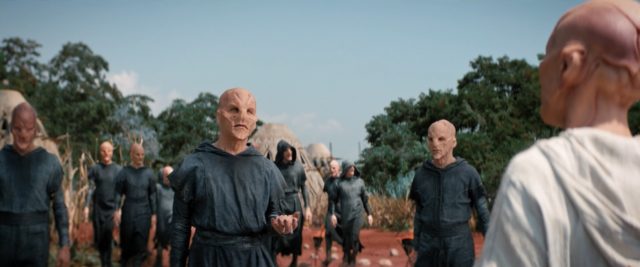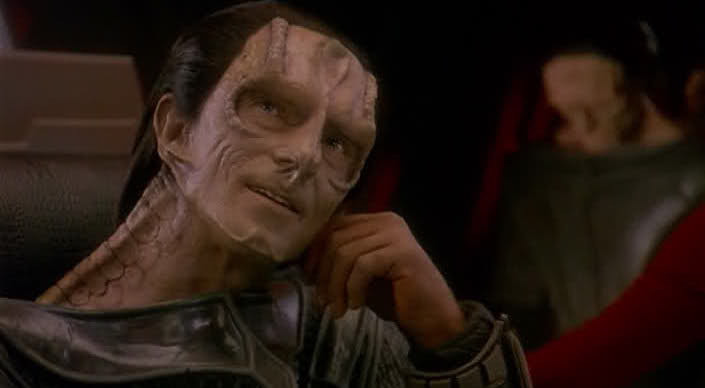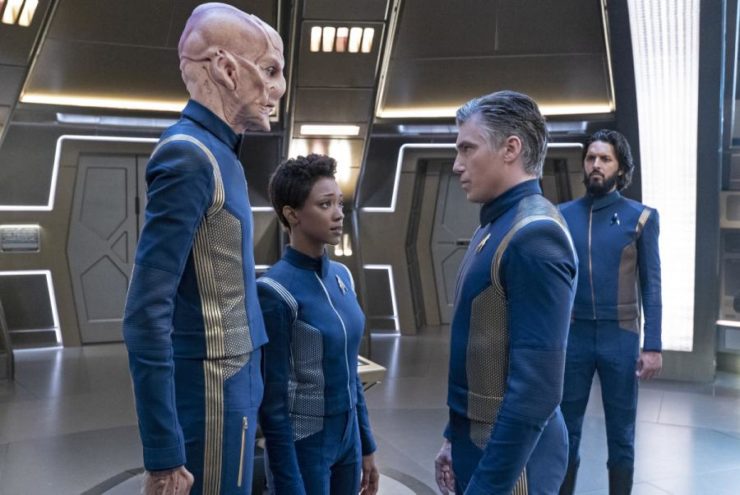In Star Trek: Discovery, Anson Mount’s Captain Pike is probably the most by-the-book Star Trek captain since Captain Picard, insofar as he’s a dude who really, really doesn’t want to violate the Prime Directive, but ends up being forced to anyway. But while the most noticeable difference between the captains might be the pacing of their storylines—Pike never even stops for a tea break!—the biggest divide comes down to the idea that the Prime Directive isn’t really the Prime Directive during the era of Discovery. In fact, it seems the second season of Discovery is all about demonstrating how the Federation’s General Order One evolves into the more strict version of the Prime Directive seen in later series.
Spoilers ahead for Star Trek: Discovery, season 2, episode 6, “The Sound of Thunder.”
Debating about the Prime Directive is pretty much the best go-to storyline of several iterations of Trek. But lately, fans and pundits have been debating about the definition of the Prime Directive in real life. In Star Trek: Discovery, no one actually calls it “the Prime Directive.” And if a casual fan wants to know why there’s a Quora page that attempts to answer exactly that. But, just like Captain Pike can’t believe everything he sees on Talos IV, you can’t believe everything you read online. Here’s the real deal: people in Star Trek: Discovery don’t call General Order One “the Prime Directive,” because Trek history demonstrates the exact definition of the Prime Directive doesn’t actually exist until toward the middle of the Original Series, in 2268, specifically, in “The Omega Glory” when Kirk actually says the words “the Prime Directive.” Discovery is currently set 11 years before that, in 2257.

So, the easy answer to the semantic question of “Prime Directive” versus “General Order One” is connected to the time period of Discovery and the wonkiness of how many qualifiers this non-interference directive really has. In “The Sound of Thunder,” Saru’s home planet of Kaminar suddenly is on the knife’s edge of General Order One for a variety of crazy reasons. For one thing, we learn that the Ba’ul became capable of warp drive twenty years prior to the episode. We’re also told this is the exact same time Saru became an asylum seeker and was rescued by Georgiou (as seen in “The Brightest Star”).
The writers of both “The Sound of Thunder” and “The Brightest Star” are Erika Lippoldt and Bo Yeon Kim, and they know exactly what they’re doing here. Back when “The Brightest Star” aired, Lippoldt suggested that the specifics of the Prime Directive aren’t as clear when Georgiou meets Sarua—somewhere in the 2230s—as they will be in Picard’s time, over a century later. “These events took place at a point in time when the Prime Directive was not so well-defined, or at the very least not as strictly enforced, compared to The Next Generation,” Lippoldt explained. “Therefore, more leeway was given for Starfleet’s commanding officers to use their discretion as to how they enforce it.”
Buy the Book


A Memory Called Empire
With “The Sound of Thunder,” Lippoldt and Kim doubled down on this idea that General Order One will evolve into the Prime Directive we see in the 24th century. Speaking to TrekMovie they said, “We did find ourselves bringing up the Cardassian occupation of Bajor quite a bit, both in terms of the oppression of one species by another, and with regards to General Order One.” This is super-interesting because the situations are nearly parallel. The Federation didn’t interfere in the Cardassian invasion of Bajor in The Next Generation and Deep Space Nine, presumably because of sticky politics, but used the Prime Directive/General Order One as the philosophical rationalization for inaction. In other words, Starfleet doesn’t mess with the Ba’ul pre-Discovery or the Cardassians pre-DS9 because they honestly just don’t want to start a war. The Prime Directive is just the rule that justifies it.
All of this tracks with what we know about Trek history at this point, but it’s relevant to note that contact with pre-warp species happens all the time in the original Star Trek, most notably in “A Private Little War,” another episode about Starfleet trying to avoid a war, and invoking the idea of the Prime Directive. Kirk and Bones don’t say the words “Prime Directive” in that episode, but Kirk does bring it up in “The Omega Glory.” Both that episode and “A Private Little War” will happen about a decade in Discovery’s future, as will the rest of Star Trek canon (other than Enterprise). Why mention this somewhat obvious fact?

Well, because it’s important to remember that, for better or for worse, Star Trek: Discovery is still a prequel—a de facto origin story for a chunk of Trek mythology. The idea that one culture with advanced technology is enslaving another culture without that tech makes General Order One/The Prime Directive a lot trickier to justify in “The Sound of Thunder” than it was in “New Eden.” Pike’s desire to preserve General Order One in “New Eden,” made a little more sense because it was clearly more possible—a pocket of pre-warp human society could conceivably be left to itself, but the centuries-long conflict between the Ba’ul and the Kelpiens has resulted in forced eugenics and slavery. In “The Sound of Thunder,” Burnham even says that all this General Order One stuff is kind of Pike’s call, implying they’re in a huge grey area (and remember: Burnham is a xenoanthropologist, and thus, presumably, familiar with the ins-and-outs of General Order One). At this point in Trek history (2257) General Order One is actually too vague to be effective. Or, too broad to be interpreted in a meaningful way. There’s nothing “prime” about this directive, because General Order One, is just too damn general. And, if the end goal of General Order One/the Prime Directive is just to keep the Federation out of crazy space wars, it makes sense the hardcore version of this rule would be born in the post-war era of Discovery.
A huge portion of this season of Star Trek: Discovery is all about meddling. Pike is meddling with the command structure of Discovery. Section 31 is meddling with regular Starfleet business. The crew is meddling with “lesser-developed” cultures on random planets. Stamets has been unwittingly meddling with the indigenous lifeforms that live in the mycelium network. And, to top it all of, the Red Angel is seemingly meddling with history itself. In the 24th century versions of Star Trek—The Next Generation, Voyager, and Deep Space Nine—characters mention the “Temporal Prime Directive,” nearly as much as the regular one. This implies that inference via time travel is just as big of a deal to Starfleet as messing with pre-warp species in real time. In fact, you could argue that nearly everything that is going wrong in all of Star Trek: Discovery is because General Order One hasn’t been drafted well. Think of it like the Articles of Confederation and the Prime Directive like the Constitution. Maybe everything we’re seeing in Discovery explains why Picard and everyone is so worried about the Prime Directive in the future.
Because, sure, the Red Angel might be messing up the timeline, but it’s the vagueness of General Order One that allows Pike and company to mess up all the time.
Ryan Britt is the author of Luke Skywalker Can’t Read and an editor at Fatherly. He is a longtime contributor to Tor.com










